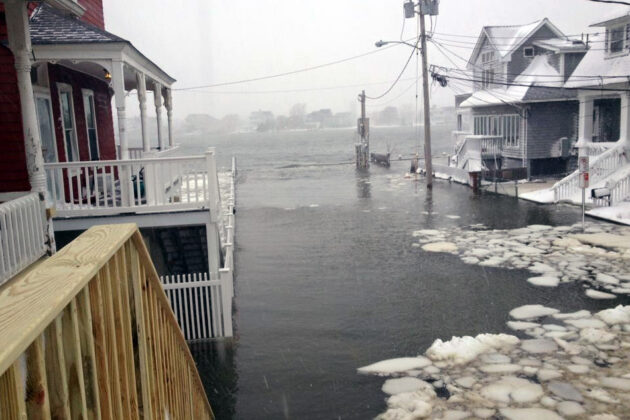When I sat down to write this blog post I was planning to create a wishlist of 2016 environmental resolutions, but I couldn’t really focus — there was a storm coming.
The threat of a snow storm is thrilling to me. Like most kids from western New York state, I was a pro at predicting school snow days, listening to the early morning wind to assess the severity of squalls of lake effect snow, knowing if conditions were just right I’d be spending the day sledding and making snow caves.
For this past January blizzard (dubbed “Jonas” by weather officials), my neighbors prepared and the power stayed on — the perfect conditions for full-on storm enjoyment — and the next day my Delaware River town was greeted by a brilliant blue sky and people in good spirits despite the shoveling.
Meanwhile, on the east coast, real-time dispatches from Jersey Hurricane News told a different story about New Jersey coastal communities. Forecasts of exacerbated storm damage during high tides turned real for Cape May County communities, suffering the worst of the state’s flooding mostly from the back bays, and Atlantic coastal communities in Monmouth and Ocean counties also felt the intensity, a reminder of the vulnerabilities of living with sea level rise, coastal erosion, and record breaking storms.
Tidal flooding facts:
RECORD FLOODING in Cape May County. 5+ foot storm surge.
At Stone Harbor's Great… https://t.co/72eHZ9cXpG
— JSHN (@JSHurricaneNews) January 24, 2016
Officials estimate the January storm caused $82 million in damage in 17 of New Jersey’s 21 counties. The State is seeking an official federal disaster declaration, a designation that would bring federal funds to cover the costs of storm damage and response.
I cannot help but feel a bit of déjà vu as communities across the state grapple with how to plan for, respond to, and pay for the damage from storm events like this. Following Hurricane Sandy, the Dodge Foundation partnered with other funders and nonprofit organizations to launch the New Jersey Recovery Fund, focusing resources and building capacity of local communities to better prepare and plan for long term resiliency.
The January storm had me wondering, what if anything has changed in how we respond and adapt?
I asked two experts from organizations working with municipalities on climate change resiliency to weigh in: David Kutner, New Jersey Future’s planning manager focusing on Superstorm Sandy Recovery; and Linda Weber, Sustainable Jersey’s Resiliency Program director.
Margaret Waldock: What has changed in the years since Sandy hit?
David Kutner: Since Hurricane Sandy, communities along New Jersey’s coastline have been battered by several storms, Jonas being only the most recent. In each case, even when storm forecasts considerably exceed their impacts — as was the case with Joaquin last October — residents experience intense stress and anxiety.
We’ve observed people take storms much more seriously, but I don’t believe we’ve reached a point yet where people are ready to make major shifts in development patterns that are likely needed to address threats associated with rising sea levels and subsiding coastlines.
I do think that people are increasingly willing to listen to the results of data-driven risk analysis pointing in that direction. We believe the community-level risk and vulnerability analysis we’ve developed through the Local Recovery Planning Manager Program effectively tells the story, and the trust and confidence we have established with local leadership has enabled community conversations.
Linda Weber: Jonas was another reminder that our local and state flood management strategies are outdated. For the past five decades, land use development and flood protection measures have been largely designed for the 1 percent storm, using FEMA issued flood maps.
But these maps and standards only represent current conditions, and do not account for sea level rise and the increasing severity of storms and precipitation due to climate change.
MW: What do you hope can change in the near future to reduce our vulnerability and the impacts from storm events?
LW: New tools, including vulnerability assessments and future flood hazard mapping, are being developed by NJDEP, NGOs and universities across the state.
But changing a half-century of policy and public investment is a huge cultural shift and won’t happen overnight. State and federal grants and technical assistance are available to help communities plan for both current and future flood hazards, and local officials should take advantage of them.
DK: The challenge is to expand the audience and sustain the conversation in more coastal communities, which is what we’d like to accomplish over the next year. There’s far more work to do before we can legitimately claim we’re moving toward resilience.
Learn more about these two programs:
With each winter storm forecast, coastal residents will once again be left to wonder if an evacuation is in the cards.
It seems that we are getting better at preparation, heeding the warnings and keeping people safe. But clearly much more is needed to ensure a longer term solution to community sustainability and resiliency in New Jersey.
 Margaret Waldock is the Environment Program Director at the Geraldine R. Dodge Foundation. Dodge’s environment grants encourage comprehensive thinking about how to safeguard our water and reinforce our natural systems in order to promote more sustainable communities.
Margaret Waldock is the Environment Program Director at the Geraldine R. Dodge Foundation. Dodge’s environment grants encourage comprehensive thinking about how to safeguard our water and reinforce our natural systems in order to promote more sustainable communities.
Photo at top is courtesy David Kutner

